Royal Arcerion Submarine Service
| Royal Arcerion Submarine Service | |
|---|---|
 Emblem of the Royal Arcerion Submarine Service | |
| Founded | 1917 |
| Country | |
| Branch | |
| Type | Submarine Service |
| Role | Subsurface Warfare, Mine Warfare, Sea-lane Denial, Special Operations, Military Intelligence |
| Size | 9,500 |
| Garrison/HQ | HMANS Chester-on-Moore |
| Nickname(s) | The Silent Service, Krakens |
| Motto(s) | "From the Depths" |
| Colors | Black, Blue, Gold |
| Anniversaries | 1917 (founding) |
| Equipment | 8 SSKs |
| Engagements | First Great War Second Great War Final War of the Deluge |
| Website | |
The Royal Arcerion Submarine Service (RASS), the Submarine Service, often referred to as the 'Silent Service' is a major offensive and sea denial component in the Arcer security strategy. It is comprised of two classes of diesel-electric submarines, and was founded in 1917 with the adoption of the first submarines into the Arcer Navy. All of Arcerion's submarines are considered SSKs, or fleet attack submarines, designed to operate in the Malentine and Songun Seas, with a limited ability to conduct power projection operations into the Polynesian Sea through the Songun Straits. The Submarine Service also has the capability to conduct sea lane denial, using torpedoes, undersea-launched cruise missiles, and various types of sea mines. Submarines also operate on conjunction with the Arcerion Special Operations Command (ASOC), to insert and extract special operations teams, conduct strategic reconnaissance and gather signals and electronic intelligence using advanced sensor suites. The Submarine Service maintains an excellent relationship with ASOC due to historical ties and joint operations during the Second Great War. They are also capable of using their integral land-attack cruise missiles in a conventional first-strike capability against a peer opponent.
As of 2026, the navy operated eight attack submarines, three of them the older Dolphin-class, and five the newer Sea Lion-class. The majority of these were deployed in the Songun Area of Operations (SAO), however news reports stated that the ACS Sea Lion, the lead ship of the newest Arcer submarine class, was spotted docked in Howland Governorate conducting Arctic Sea Trials and ice shelf breaching operations.
History
Founding
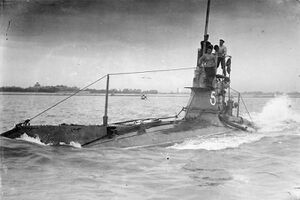
After the First Great War Arcerion Naval headquarters identified the need to a domestic and littoral capability for undersea warfare. This eventually resulted in the purchase of several used submarines from Burgundie, and instructors to train Arcer crews. This was the initial foundation for the Arcerion Academy for Undersea Warfare, which would eventually be renamed in the 1950s to the Subsurface Warfare School (SSWC). Trials on the submarines began and initial drills including crash dives, torpedo warfare, and a nascent mine laying capability to ensure the Arcerion sovereignty over its Exclusive Economic Zone (EEZ) in the Malentine and Songun Seas. Over the next two decades until the outbreak of the Second Great War the Submarine Service continued to grow. Advancements in bubble and wake-free torpedoes began to be introduced, modern High-Frequency Radios, and increased hull protection and dive depths all were developed through native shipyards in Port Gibson, Foxhey Governorate. During this time, the submarine service also practiced with the practice of inserting agents or special forces teams over-the-beach at night, a tactic that would be first used operationally with the reconnaisance of beachheads and landing zones for Operation Lightfoot several years later.
The submarine service consisted of twenty-seven submarines, several submarine tenders and support vessels such as rearmament and refueling ships. Arcerion Naval HQ placed a high emphasis on the ability to rearm, refuel and repair submarines underway at sea away from a safe port-of-call, as the littoral nature of the Malentine and Songun Seas meant that maritime patrol aircraft and sabotage on port facilities could prevent the effective deployment of submarines during wartime.
Second Great War
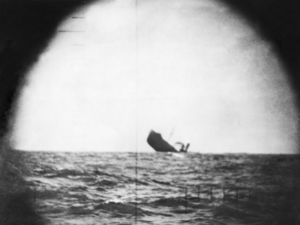
See Also: Operation Forefront
During the Second Great War Acer submarines saw extensive action against The Capetian Navy, operating in the Songun Sea and the Polynesian Sea. This was part of the larger Arcer naval mission to deny the Capetian Navy freedom of navigation and freedom of movement in the Songun sea, as well as conduct sea lane denial and commercial raiding to prevent the Cape from receiving the necessary materials and supplies it required to sustain its own war effort. Arcer submarines achieved the most success, as the Arcer surface fleet and Capetian Navy's capital ships never engaged directly in a major battle, the largest being a few smaller flotilla-sized actions between groups of escort ships that happened to make chance contact. Submarines operated under the umbrella mission of Operation Forefront, however under the command of Rear Admiral Lawrence Arthur Coxley, who was acting as Commander, Submarine Force, the Arcer Subsurface fleet operated under Operation Flyhook, which was the sea lane denial, commerce raiding, and minelaying conducted by the submarine force at this time.
Overall, Arcer submarines achieved great effect, sinking dozens of Capetian, Caphirian, and Daxian-flagged merchantmen, as well as a number of smaller Capetian warships of corvette and frigate-size. Moderate damage was done to Capetian major capital ships, although none were sunk, just forced into shipyards for repairs. During the war, four Arcer submarines were damaged by enemy fire or anti-submarine warfare, and an additional two were lost. His Majesty's Arcer Submarine Superior, was destroyed by enemy surface vessels, likely due to depth charges and being unable to surface in 1951. HMAS Typhoon was lost with all hands during an emergency dive rehearsal as part of crew training in the Malentine Sea, where it sunk to 300 meters and was destroyed. The legacy of the war continues to influence modern Arcer submarine doctrine. An emphasis on torpedo and mine warfare are consistently emphasized as the most important aspects of the Service's capabilities, and while it maintains the ability to launch cruise missiles and anti-ship missiles, these are considered of secondary nature.
Antebellum Period
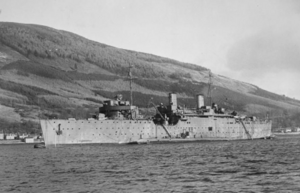
After the Second Great War a drawdown in the submarine service's size was in line with other defense cuts, as the federal government of Arcerion was legislated by the Confederate Parliament to begin a period of austerity to economically recover from the financial stress of the war. The Service's twenty-five submarines were reduced to twelve, and crew training and maintenance budgets were cut in favour of future procurement and long-term success into the 1970s and 1980s to maintain relevance. Despite the risk of being unprepared for a peer conflict in the 1960s, 1970s, and 1980s, this ultimately proved fruitful as the focus on research and development, as well as maintaining a small but professional and specialized officer and NCO corps meant that by the arrival of the modern and incredibly capable Dolphin-class in the early 1980s, the submarine service was again allocated larger budgetary spending and ability for expansion, as the peacetime Naval Service focused on sea lane protection and naval sovereignty and expeditionary movement of land forces was undergoing a period of reshaping.
Modern History
Telekonese Conflict
Varshan and 21st Century
Arcer submarines saw a return to their traditional roles during the Final War of the Deluge, with extensive action against Varshani Navy throughout the course of the conflict. Submarines were the first Arcer naval combatants to engage an enemy in open and armed conflict since the Second Great War. It saw the commitment of the entire Submarine Service, operating out of Joint Naval Station Leighton-Lennox, which was at the time still under construction, and Arcerion operated out of leased bases from the Kiravian Navy. Arcer submarines primarily saw action between the Seneca Islands and Anta Carda, conducting commerce raiding, mine laying, and interdicting Varshani naval vessels.
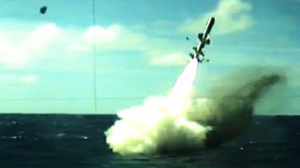
No Arcer submarines were lost or damaged, and a sizeable amount of Varshani commercial and merchant marine shipping was lost to Arcer Submarine engagements during the course of the conflict. Due to the green-water and littoral nature of the service prior to the war, this was the first open water or 'blue-water' deployment on an extensive, and continual basis for much of the Arcer Naval Service. The result was in increased understanding of the difficulties and challenges of operating under such conditions, and required a rethinking of the Service's underway and at-sea replenishment of submarines. While the doctrine was not fundamentally changed, the Service acknowledge that it was considerably more difficult to conduct open sea missions of this nature. The war against Varshan also saw the first employment of land-attack cruise missiles by the Submarine Service, with the ACS Gibson engaging several Varshani targets in the fall of 2020 as part of ongoing targeting of key Varshani infrastructure and command nodes. While submarine's activities are kept classified and not disclosed to the public, the government of Arcerion has acknowledged that members of the Royal Arcerion Naval Service/Arcerion Special Operations Command's Marine Commandos were inserted for clandestine reconnaissance and direct-action missions during the course of the war.
Subsurface Warfare School (SSWC)
The Subsurface Warfare School (SSWC) is one of the most difficult Arcerion officer qualifying courses. It is a mandatory course for all officers, regardless of trade or rank, to complete before they are permitted to serve on an Arcer submarine. It is an extensive 32-week long process that takes place on an Arcer submarine covering a variety of undersea warfare topics. The inaugural course which was only five weeks long, was run in 1918 after the arrival of used submarines from Burgundie. It is widely regarded as one of the most difficult courses in the Arcer military, due to the long hours, cramped and small living quarters, extended periods underwater, and difficult scenarios, usually culminating with one-third of graduates failing or not meeting the standards.
Foriegn officers are permitted to partake in the course, with visiting Naval Officers given a bottle of Arcer Gin as a graduation gift upon successful completion, as well as a set of Royal Arcerion Naval Service dolphins, indicating they are an honourary member of the Submarine Service.
Doctrine and Role
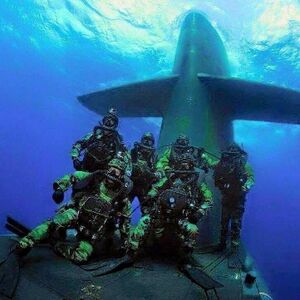
The Royal Arcerion Submarine Service covers a variety of undersea warfare, seabead warfare, and intelligence collection activities to support the foreign and domestic interests of Arcerion. The most modern is with the introduction of the Dolphin-class of submarines in the 1980s with a modern suite of sophisticated electronics for the collection of electronic intelligence. This has resulted in the continuous and clandestine deployment of Arcer submarines around Southern Crona and Sarpedon on missions to collect military intelligence on foreign navies, ports, and commercial facilities. As part of its intelligence collection mandate this often incorporates cooperation with Arcerion's maritime special operations unit, the Arcerion Regiment of Marine Commandos. The Arcerion Special Operations Command has operated off of submarines since the Second Great War, and it is a core component that is expected of the Submarine Service to maintain proficiency on. This culminated recently with operations against Varshan.
Submarines also can covertly communicate using High-Frequency (HF) and Low-Frequency (LF) radios. This is also one of the functions of the Satellite Transmission Stations of the Arcerion National Space Exploration Agency, which is to provide satellite and High-Frequency receive and transmit stations to support the Royal Arcerion Naval Service during expeditionary deployments in the Odoneru Ocean, Polynesian Sea, and Ocean of Cathay.
While historically not used, the use of land-attack cruise missiles is a skill maintained by the Submarine Service, which is usually in conjunction with Special Forces teams embedded for reconnaissance and call-for-fire, to provide correction as well as to laser-designate targets as needed.
Submarines in Arcerion predominantly focus on two main mission sets, that being sea lane denial, and subsurface warfare (torpedoes/mines). The first of these missions is focused on maintaining Arcer sovereignty and freedom of movement for the Warrington and Songun Straits. In doing so, the submarines regularly practice the ability to attack merchant shipping, support and logistics vessels of foreign merchant marine services, and the engagement of enemy submarines conducting similar missions. This is also related to the heavy emphasis that the Arcer government and Naval Service Headquarters places on the use of torpedoes and sea mines. The submarines have a variety of sea mines, both predominantly use moored-mines for denying access to ports or shallow-water interdiction of ships, and torpedo mines that lay on the seabed until they recognize the sound signature of an enemy surface vessel and are deployed to engage. Limpet mines are also frequently exercised with the Marine Commandos, and Arcer subs serve as the launch and recovery vessel of choice for such Commando operations.
Traditions
There are a number of interesting and historical submariner traditions that do not exist or have equal within the surface fleet of the Royal Arcerion Naval Service.
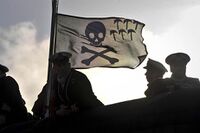
Pirate and Raiding Traditions
Depsite the traditional Arcer distaste of pirates and seafaring marauders due to the historical association with indigenous pirates in the Malentine Sea, the Submarine Service opted to coopt the use of the Jolly Roger as its unofficial banner and ship's flag during the Second Great War. Ships returning from successful voyages during the war with vessels they had destroyed was permitted by the Arcer Admiralty to fly a Jolly Roger, with a smaller place triangle pennant to indicate number of vessels destroyed. The record belongs to HMAS Tiger, which sank fifteen enemy ships in a single voyage through the Songun Straits and into the Polynesian Sea, requiring a torpedo resupply part of the way through its voyage, which was successfully completed off the coast of Kiravian-controlled Æonara.
Dolphin Insignia
The dolphin insignia continues to one of Ixnay's most common symbols for submariners, representing the duality of surface and below-sea life of most members of the submarine service. Arcer Officers receive their insignia after completion of the Subsurface Warfare School, and non-commissioned members after the completion of their respective trades training and emergency procedures indoctrination. Sailros are permitted to wear the insignia for the duration of their careers, including once back in a staff and command role, at a training school, or on later sails with the surface fleet.
Active Submarines
Fast Attack Submarines
Dolphin-class
The Dolphin-class is Arcerion's oldest submarine class still in service, and currently is comprised of three submarines in the class, the ACS Reforge, Venture, Sly. These are older submarines, built by Foxhey Shipyards in 1977 and the final submarine was completed in 1981. All were in service and finished sea trials by 1982, and have seen continued deployment and operational tasks since then by Naval Service HQ. Arcerion plans to retain its three older submarines, transitioning them into a littoral role for the Malentine Sea, to free up the newer Sea Lion-class for service in the Songun Sea and abroad.
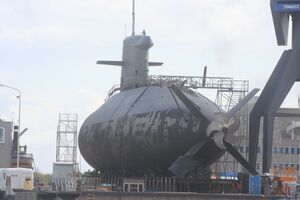
The Dolphin Class saw service during the Final War of the Deluge, primarily serving in the commerce raiding and attiring of Varshani merchantmen along the Seneca-Anta Carda Gap. Reforge was personally awarded a Prime Minister's Commendation for its actions in destroying multiple Brigade and Corps Headquarters using land-attack cruise missiles launched from the submarine. Concurrently, it also engaged a series of Varshani merchant ships disguised as Sarpedonian-flagged freighters, but were smuggling weapons. Reforge successfully engaged and sunk five Varshani merchantmen and one Varshani offshore patrol vessel during the war, making it the most effective Dolphin-class deployed on combat operations. All submarines are expected to continue service into 2040, with life cycle and capability upgrades completed for 2010 and 2020, and planned improvements scheduled for 2030 and 2035.
Sea Lion-class
Sea Lion, Gibson, Lion, Tiger, Barracuda represent Arcerion's newest class of submarine and the current workhorse of the Submarine Service. They are primarily engaged with deployments to the Songun and Polynesian Seas, although the Sea Lion was spotted in Howland Governorate conducting Arctic Trials as part of the Arcerion Navy's commitment to maintaining its Arctic sovereignty.
The Sea-Lion class serve as the basis for much of the Service's daily operational output. They have modern sensor suites for the collection of intelligence, are exceptionally quiet as they are diesel-electric boats, much like the Dolphin-class, and are primarily aimed at subsurface warfare and the engagement and destruction of enemy surface ships. All ships of the Sea Lion-class engaged and destroyed Varshani ships or Varshani-allied vessels during the Final War of the Deluge. The class also assisted with the sea trials for increased operational effectiveness of the at-sea repleenishment of submarines using submarine tendes. In this instance, Arcerion is one of the few modern navies that still conducts submarine replenishment at-sea, a unique capability that it maintains.
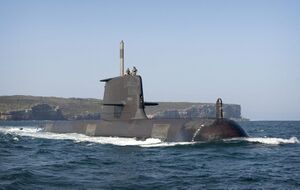
The class has received upgrades since they began to finish sea trials and construction in the late 1990s and early 2000s, ensuring they are still modern boats capable of conducting missions expected of a modern Navy. Unlike the older Dolphin-class, the Sea Lion-class has very little public scrutiny or publicly available information due to the protected nature of the Service's work. As such, details such as maximum dive depth, exact armament, and crew complement are only estimated based off of other contemporary designs from other Occidental nations.
Future Subsurface Combatant Programme (FSSCP)
The Arcer Navy in its 2025 Memo on Naval Defence and Security outlined the requirement for the Future Subsurface Combatant Programme (FSSCP), with the expected result of the delivery of five new Sea Lion-class submarines to be delivered by the end of 2030. They will be designated Sea Lion Block IIs, and the bid is currently out for government tender, with a number of domestic shipyards in Foxhey and Chester-on-Moore competing against foreign buyers. The intent is to increase the number of available boats to ensure green-water and blue-water effects simultaenously in the event of a near-peer conflict.
Arcerion Submarine Service Record
The Arcerion Submarine Service Record is an annual gazette published by the Honourable Association of Arcer Submariners that chronicles yearly stories submitted by association members and logs significant appointments and accomplishments within the service. First published in 1920, it is one of the longest serving magazines and gazettes in Arcerion that has continuously published and printed without change or stopping circulation. The publication also includes information on current and former serving members now in government and other positions, and annually awards the 'Submariner of the Year,' as well as 'Senior Submariner,' awards to its members. The Record during wartime is also the only official non-public source accredited by the Arcer government to publish reports (sanitized and redacted of classified information) of sea voyages of Arcer submarines, their actions, and destroyed enemy vessels.